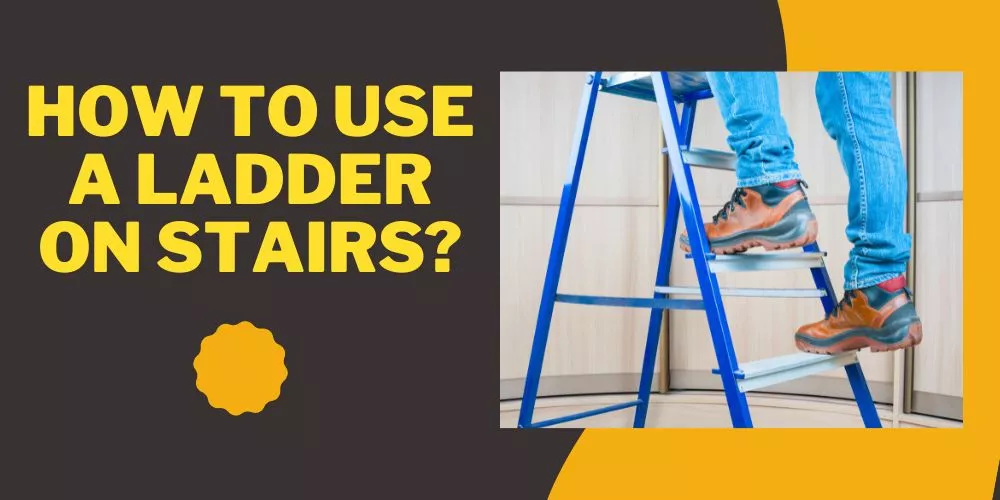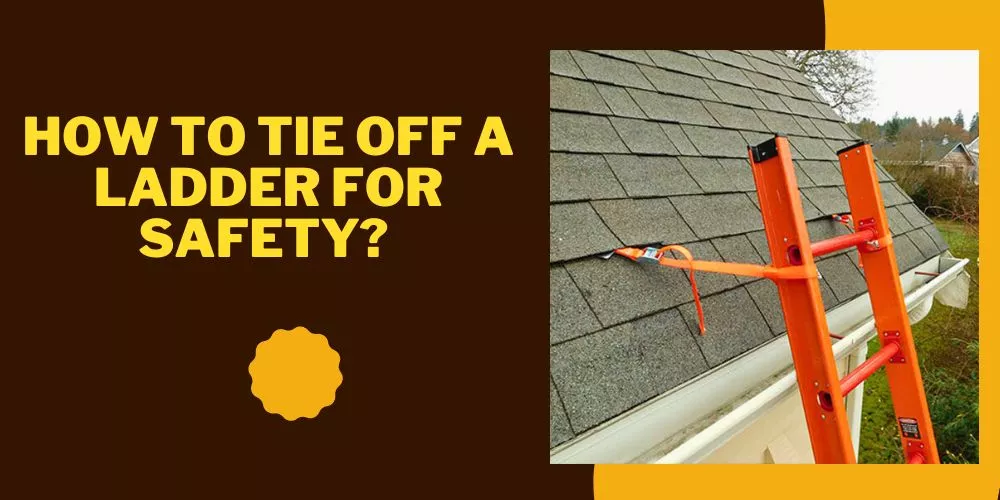Roof maintenance and repair tasks can be challenging, especially when dealing with steep slopes and uneven surfaces.
That’s why it’s essential to understand the proper ladder selection, positioning, and use of safety equipment to minimize risks and maximize productivity.
In this article, I will discuss the key factors to consider when choosing the right ladder for the job, how to put a ladder on a sloped roof, and the essential safety equipment you should always use.
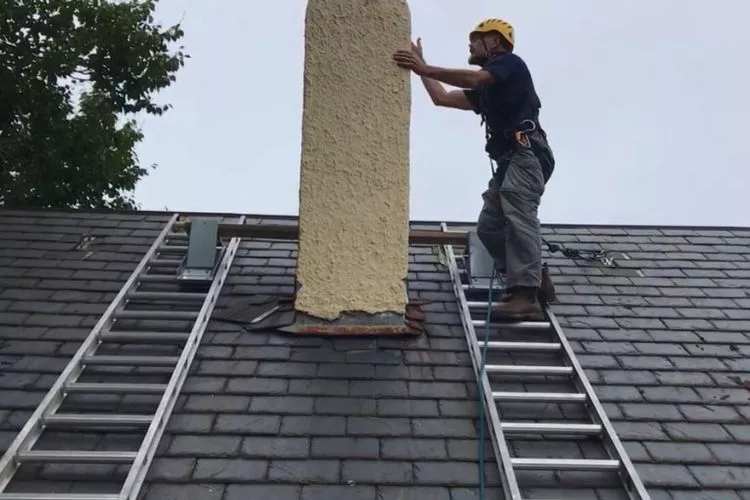
How to put a ladder on a sloped roof? (An Easy Guide)
Here I will discuss the different types of ladders suitable for use on a sloped roof, how to choose the right ladder for your specific needs and provide step-by-step instructions for placing and securing the ladder to ensure your safety.
🪜Securing the Ladder on a sloped roof
To ensure your safety while working on a sloped roof, it is crucial to secure the ladder properly. Consider using one or more of the following methods to provide stability and prevent accidents.
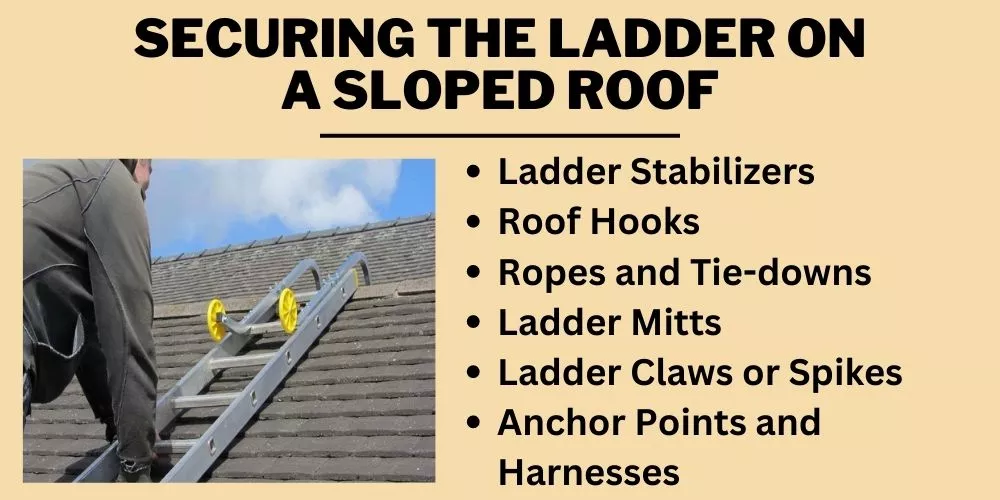

Ladder Stabilizers
Ladder stabilizers attach to the top or sides of the ladder, extending its contact points and providing additional support. They help prevent the ladder from slipping or tipping by distributing the weight more evenly and resting against the roof or wall.
There are several types of ladder stabilizers available, such as:
- Stand-off stabilizers: These stabilizers have wide arms that extend horizontally, keeping the ladder away from the wall or roof edge and providing a more stable base.
- Corner stabilizers: Designed for tight spaces, corner stabilizers have a V-shaped design that allows the ladder to rest securely against inside or outside corners.
When using a ladder stabilizer, ensure it is compatible with your ladder and installed according to the manufacturer’s instructions.
Roof Hooks
Roof hooks are U-shaped attachments that secure the top of the ladder, allowing it to hook over the ridge of the roof. They provide additional stability when working on sloped surfaces by preventing the ladder from sliding or tipping. To use roof hooks effectively:
Attach the roof hooks to the top of the ladder, following the manufacturer’s guidelines. Raise the ladder and carefully slide the hooks over the roof’s ridge. Ensure that the hooks are securely in place and that the ladder rests evenly on both sides of the roof.
Ropes and Tie-downs
Using ropes and tie-downs to secure the ladder to a fixed point on the roof can provide extra stability and prevent movement while working. To use ropes and tie-downs effectively:
- Choose a strong, fixed anchor point on the roof, such as a chimney, vent pipe, or structural beam.
- Attach a rope or tie-down strap to the anchor point, ensuring it is secure and tight.
- Loop the rope or strap around the ladder, preferably at a point close to the roof’s edge, and fasten it securely.
- Double-check that the ladder is stable and that the rope or strap is tight and secure before starting work.
Ladder Mitts
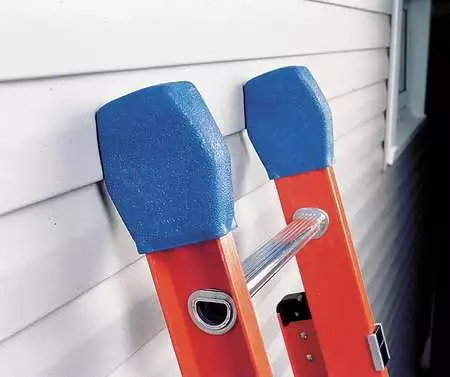

Ladder mitts are rubber or foam pads that cover the top of the ladder’s rails, providing extra grip and protection against damage to the roof or wall. They can help prevent the ladder from slipping and reduce the risk of scratching or denting the surface it’s leaning against.
Ladder Claws or Spikes
Consider using ladder claws or spikes for added stability on soft or slippery surfaces. These devices attach to the bottom of the ladder’s feet, providing extra grip and preventing the ladder from sinking into the ground or sliding on wet or icy surfaces.
Anchor Points and Harnesses
For maximum safety when working on a sloped roof, consider using a personal fall arrest system (PFAS) that includes an anchor point, a full-body harness, and a shock-absorbing lanyard.
While this method doesn’t directly secure the ladder, it provides an additional layer of protection by preventing falls if the ladder becomes unstable.
Using one or more of these methods to secure your ladder on a sloped roof can significantly reduce the risk of accidents and ensure your safety while working at height.
Always follow the manufacturer’s instructions and safety guidelines for your ladder and any additional equipment.
What kind of ladder to get on the roof?
- Extension Ladders: These can be extended to various lengths, making them suitable for accessing different roof heights. They are not self-supporting and need to lean against a stable surface, such as the side of a house or building.
- Combination Ladders: Combination ladders are versatile and can be used as a step ladder, extension ladder, or scaffold. They have adjustable sections that can be locked into place, making them suitable for use on uneven surfaces like sloped roofs.
- Roof Ladders: Roof ladders are specifically designed for use on roofs and typically have hooks that can be secured over the roof’s ridge. These ladders provide better stability and safety when working on sloped surfaces.
Choosing the Right Ladder For a Sloped Roof
Selecting the appropriate ladder for your needs ensures safety and efficiency while working on a sloped roof. Consider the following factors when choosing the right ladder:
🪜Slope and Height of the Roof
The slope and height of the roof are important factors in determining the appropriate length and type of ladder needed. To accurately measure these dimensions:
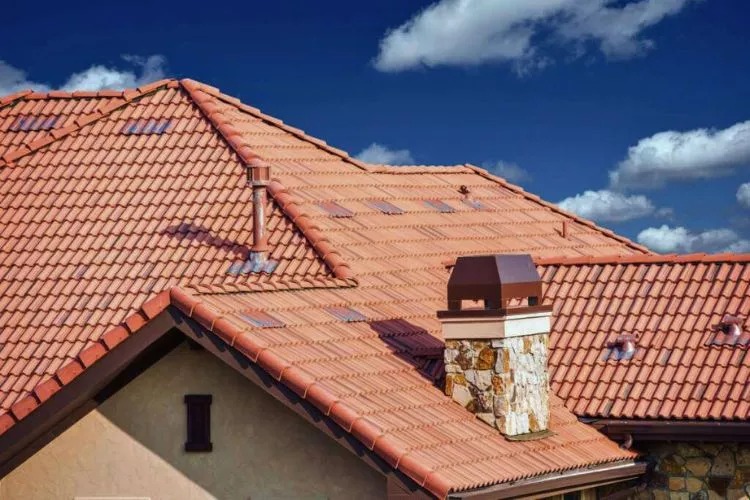

- Height: Measure the vertical distance from the ground to the roof’s edge where you’ll place the ladder. This will help you determine the required ladder length. Remember that the ladder should extend 3 feet above the roof’s edge for safe transitioning.
- Slope: Determine the roof’s slope by measuring the vertical rise (in inches) for every 12 inches of horizontal run. This measurement is typically expressed as a ratio, such as 4:12 or 6:12. Knowing the roof’s slope can help you choose the right ladder and accessories, such as ladder stabilizers or roof hooks, designed for use on sloped surfaces.
🪜Type of Work
The nature of the work you’ll perform on the roof is another essential factor in selecting the most suitable ladder. Some common tasks and their specific ladder requirements include:
- Cleaning gutters: A combination or extension ladder with a stabilizer that rests against the roof or wall can provide the necessary stability and access for gutter cleaning.
- Repairing shingles: A roof ladder with hooks that secure over the ridge is ideal for shingle repair tasks, as it provides better stability and allows you to work hands-free.
- Installing solar panels: A combination ladder or scaffold system may be more appropriate for large-scale installations like solar panels, as it offers a stable platform for carrying and positioning heavy equipment.
- Painting or maintenance: For tasks that require frequent repositioning of the ladder, such as painting or general maintenance, a combination ladder with adjustable sections is a versatile option that can adapt to different roof heights and slopes.
🪜Material and Weight Capacity
Consider the ladder’s material and weight capacity to ensure it can safely support your weight and any tools or materials you’ll be using. Common ladder materials include:
- Aluminum: Lightweight and rust-resistant, aluminum ladders are suitable for most general-purpose tasks. However, they should not be used near electrical sources, as they can conduct electricity.
- Fiberglass: Fiberglass ladders are non-conductive, making them ideal for working near electrical sources. They are also more durable and weather-resistant than aluminum ladders but tend to be heavier and more expensive.
Ensure that the ladder’s weight capacity, usually indicated by its duty rating (such as Type I, Type II, or Type III), is sufficient to support your weight and the weight of any tools or materials you’ll be using on the roof.
By carefully considering these factors, you can choose the right ladder for your specific needs, ensuring your safety and efficiency while working on a sloped roof.
How do you carry a ladder up a ladder on a roof?
Carrying a ladder up a ladder on a roof can be challenging and potentially dangerous. To ensure safety, follow these steps:
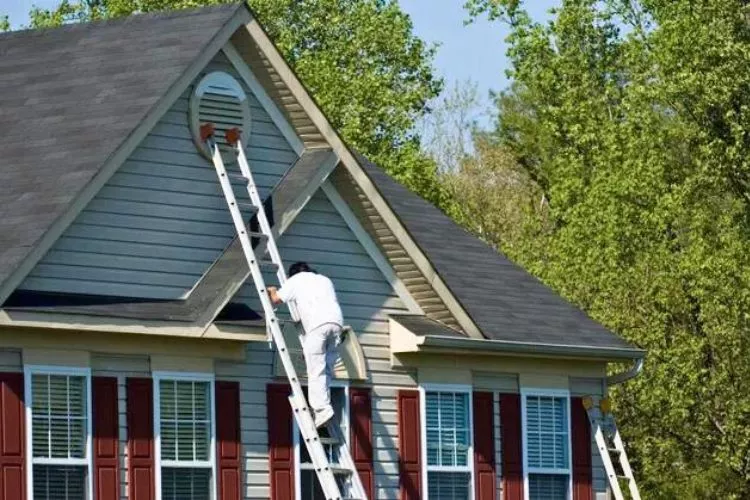

- First, set up the base ladder at the correct angle (75.5 degrees) and ensure it extends at least 3 feet above the roofline for secure transitioning.
- Secure the base ladder to the roof or ground using stabilizers, hooks, or tie-downs to prevent slipping or tipping.
- To carry the second ladder up, position it parallel to the base ladder and secure it with ropes or straps. This will allow you to climb the base ladder while holding onto the second ladder, keeping both hands free from climbing.
Always exercise caution and follow safety guidelines when working with ladders on a roof. If possible, consider using alternative methods or equipment, such as scaffolding or a combination ladder, to minimize the need for carrying a ladder up another ladder.
frequently asked questions (FAQs)
How do you put a ladder on a roof without damaging shingles?
Use ladder stabilizers or stand-off arms to keep the ladder away from the shingles, and place ladder mitts or padding on the ladder’s contact points to prevent scratches or dents.
Can you use an A-frame ladder on a roof?
No, A-frame ladders are not designed for use on roofs. Instead, use an extension ladder, a combination ladder, or a roof ladder specifically designed for sloped surfaces.
How safe are roof ladders?
Roof ladders are safe when used correctly, following the manufacturer’s guidelines, and with proper safety measures, such as securing the ladder, using personal fall protection equipment, and adhering to safe working practices.
Conclusion:
Setting up a ladder on a sloped roof requires careful planning, the right equipment, and adherence to safety guidelines.
By selecting the appropriate ladder type, securing it with stabilizers, hooks, or tie-downs, and using additional safety measures such as roof hooks, ladder levelers, and personal fall protection equipment, you can minimize the risk of accidents and ensure a safe working environment.
Always follow the manufacturer’s instructions for your ladder and any additional accessories, and exercise caution when working at height.
With the proper approach and attention to safety, you can confidently tackle tasks on sloped roofs and complete your projects efficiently and securely.

